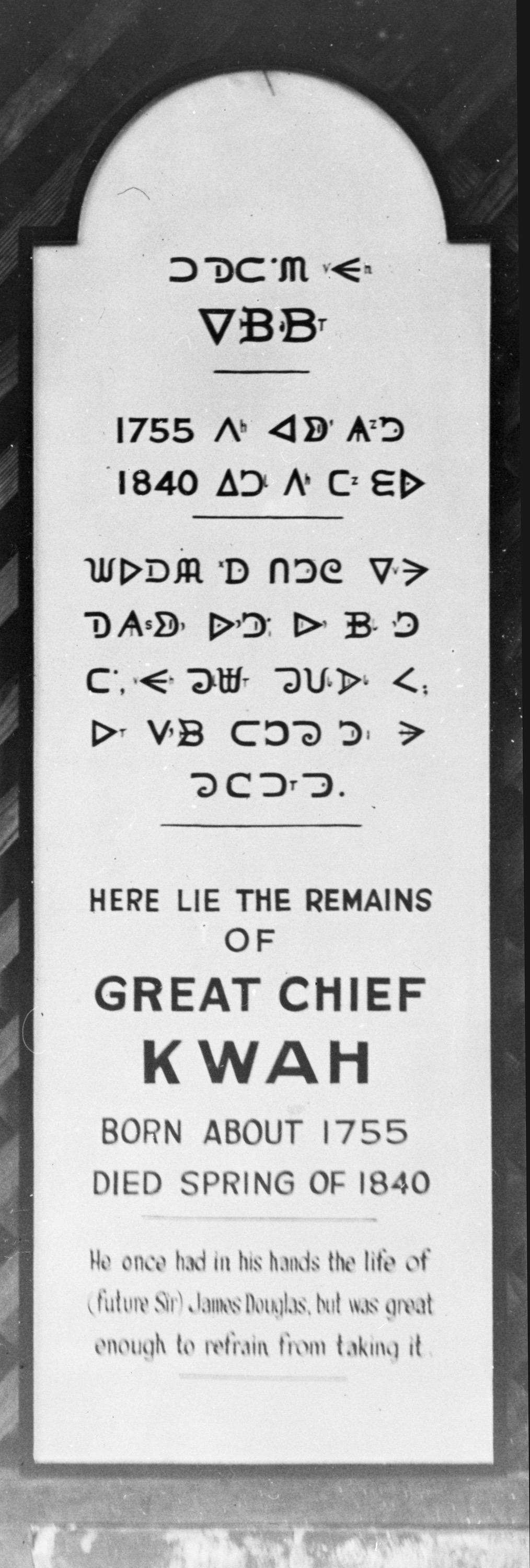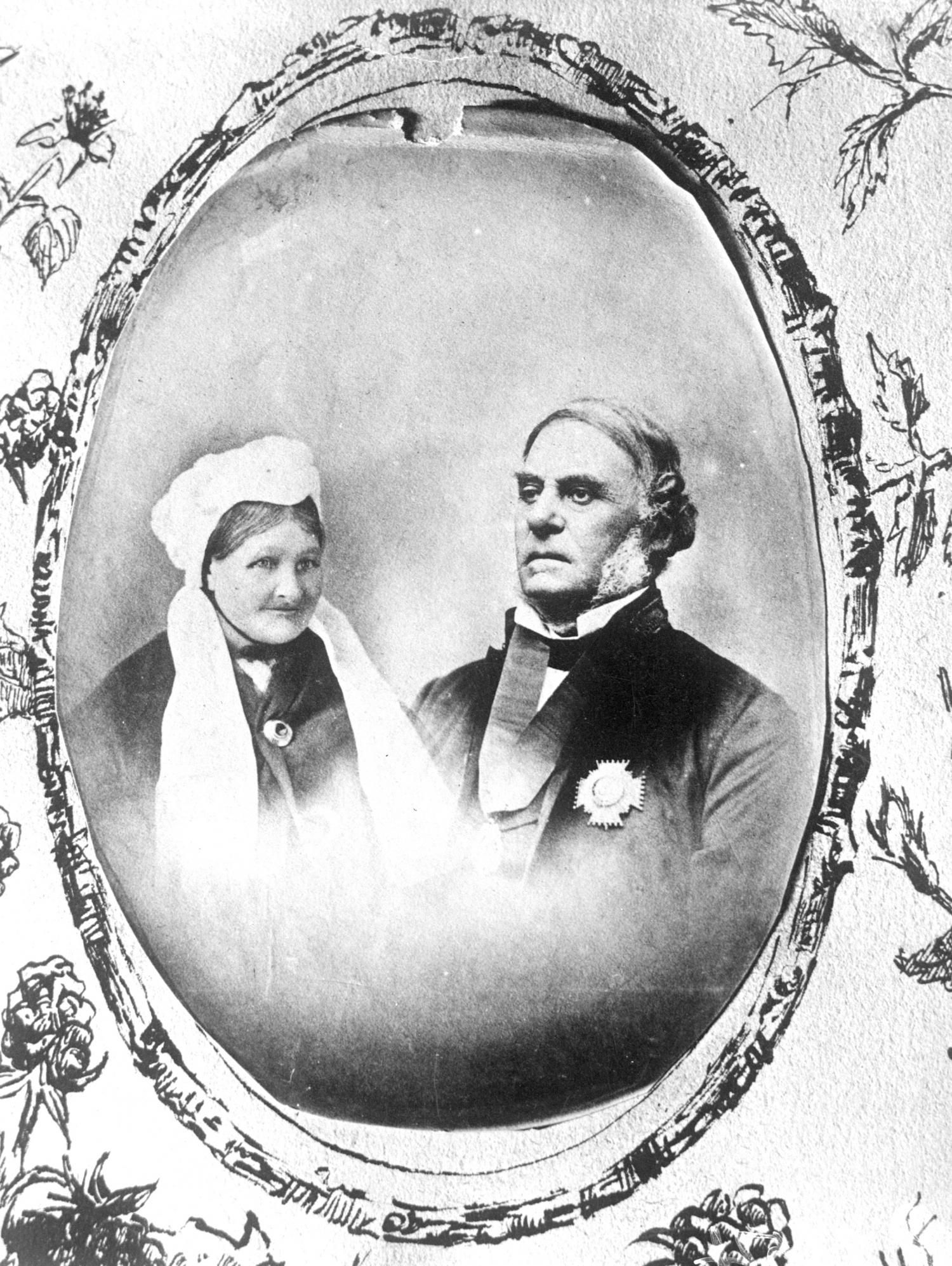Chief Kw’eh Spares Douglas
The future father of British Columbia’s brush with death
Date: 1828
Nobody knows precisely how Chief Kw’eh came to spare the life of a young James Douglas. Multiple versions of the story exist. But they all begin with the murder of two Hudson’s Bay Company (HBC) fur traders stationed at Fort George, now Prince George, in 1823. One of the two Dakelh men responsible was killed shortly after, though it is unclear by whom. The other, believed to be named Tzoelhnolle, evaded punishment for five years.
In the summer of 1828, a 25-year-old James Douglas was overseeing the HBC’s outpost at Fort St. James, on the eastern end of Stuart Lake. When Douglas heard Tzoelhnolle was nearby, he was “determined that the blood of the white man should not be unavenged,” according to the memoir of an HBC trader. In one retelling, Douglas attempted to kill the fugitive himself. When his blunderbuss narrowly misfired, his men beat Tzoelhnolle to death. In another version, Tzoelhnolle is captured, brought before Douglas and hanged. “The man he killed was eaten by the dogs,” the young clerk reportedly declared. “By the dogs, he must be eaten.”
Douglas didn’t publicly discuss this incident much. However, he did address it decades later in response to a newspaper story on him: “True, I seized the Indian, a noted murderer, as stated, and secured him after a desperate struggle, but I did not shoot him with my own hands; he was afterwards executed for his crimes. It was a desperate adventure, which nothing but a high sense of duty could have induced me to undertake.”
Days after Tzoelhnolle’s death, an angry Chief Kw’eh, a legendary Dakelh leader and distant relative of Tzoelhnolle, visited Douglas at Fort St. James. Though the particulars differ, all versions involve an armed ambush by Kw’eh and his men. Douglas’s life lay in Kw’eh’s hands. Here, too, the details are unclear. But in nearly all accounts, one or more people intervened and convinced Kw’eh to spare Douglas’s life.
Amelia Douglas, the fur trader’s new wife who was Swampy Cree and Scottish, was perhaps more adept to Indigenous customs than her husband and his colleagues. Fearing Kw’eh might act, she quickly collected some tobacco, clothing, blankets and several other items and laid them before Kw’eh’s feet as gifts in exchange for her husband’s life. In this recount, Kw’eh accepted the goods and the blade was removed from Douglas’s throat.
Whatever may have happened that day will never be known. But the importance of Kw’eh’s fateful decision to let Douglas live cannot be understated. In the years that followed, Douglas continued to rise the ranks of the HBC. In 1851, 22 years after nearly losing his life, he became the Colony of Vancouver Island’s second governor. Douglas went on to become the mainland’s first governor in 1858, leading both colonies until his retirement six years later. Meanwhile, Kw’eh remained a monumental figure in relations between early settlers and Indigenous people. His descendants remember him as a generous but shrewd peacemaker, the “dreamer of the salmon.” Unlike his ancestors who were cremated, Kw’eh is buried at the mouth of the Stuart River, across from where he once watched the salmon run.
Sources:
1. Bancroft, Hubert Howe. “History of the Pacific States of North America: The Northwest Coast.” A.L Bancroft, 1884, books.google.ca/books?id=KroUAAAAYAAJ&lpg=PA475&dq=This%20story%20has%20been%20harped%20in%20variations%20by%20almost%20as%20many%20authors%20as%20have%20given%20us%20gunpowder%20plots&pg=PA475#v=onepage&q&f=false.
2. Bishop, Charles A. 'KWAH. Dictionary of Canadian Biography, www.biographi.ca/en/bio/kwah_7E.html.
3. “Chief Kw'eh.” Fort St. James National Historic Site, Parks Canada, www.pc.gc.ca/en/lhn-nhs/bc/stjames/info/phn-pns/kweh.
4. Coats, Robert Hamilton, and R. E. (R. Edward) Gosnell. “Sir James Douglas.” University of British Columbia Open Collections, T.C. and E.C. Jack, 1908, open.library.ubc.ca/collections/bcbooks/items/1.0348965#p124z-3r360f:Tzoelhnolle.
5. Stephen R. Bown. “The Company: the Rise and Fall of the Hudson's Bay Empire.” Doubleday Canada, 2020, p. 395, books.google.ca/books?id=ukEAEAAAQBAJ&pg=PA395&lpg=PA395&dq=kw%27eh+james+douglas&source=bl&ots=LUcjhlDF7d&sig=ACfU3U3_Pda-3CfCfilnk2dhuqKc3jpxyw&hl=en&sa=X&ved=2ahUKEwj-gKKSmNvuAhWeGDQIHZQCB9M4ChDoATAAegQIBRAC#v=onepage&q=kw'eh%20james%20douglas&f=false.
6. Kwah's Dagger, Royal BC Museum and Archives, royalbcmuseum.bc.ca/exhibits/living-landscapes/upperfraserbasin/kwah_dagger/oral_history.html.
7. Lloyd, Ruth. Chief Kw'eh Recognized Nationally. Vanderhoof Omineca Express, 18 Apr. 2012, www.ominecaexpress.com/community/chief-kweh-recognized-nationally/.
8. Maureen, Fiona. Great Leader Carrier Chief Kw'eh Honoured. Caledonia Courier, 26 July 2017, www.caledoniacourier.com/local-news/great-leader-carrier-chief-kweh-honoured/.
9. McLean, John. “John McLean's Notes of a Twenty-Five Year's Service in the Hudson's Bay Territory.” University of British Columbia Open Collections, The Champlain Society, open.library.ubc.ca/collections/bcbooks/items/1.0375700#p204z-3r0f:
10. Morice, A. G. (Adrien Gabriel). “The History of the Northern Interior of British Columbia (Formerly New Caledonia) 1660 to 1880. With Map and Illustrations. Third Edition.” University of British Columbia Open Collections, William Briggs, 1905, open.library.ubc.ca/collections/bcbooks/items/1.0226336#p178z-3r0f:Tzoelhnolle.




